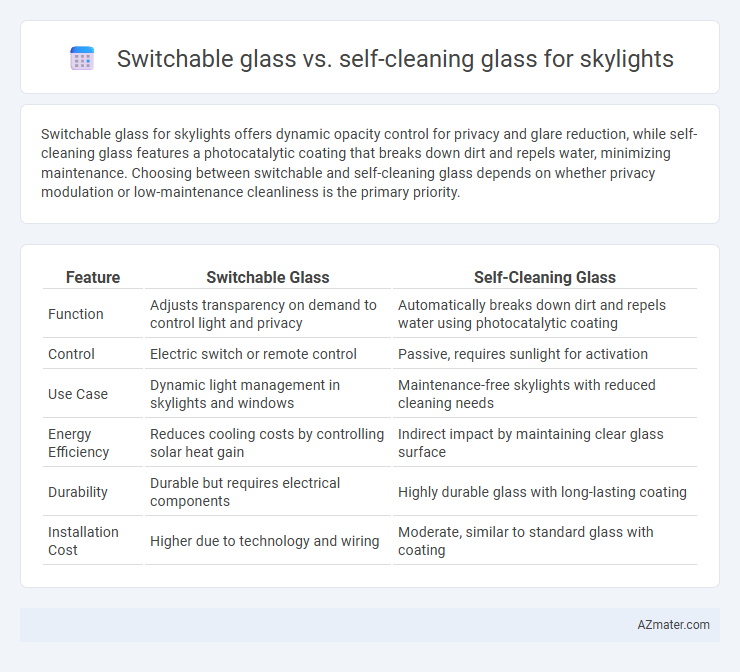Switchable glass for skylights offers dynamic opacity control for privacy and glare reduction, while self-cleaning glass features a photocatalytic coating that breaks down dirt and repels water, minimizing maintenance. Choosing between switchable and self-cleaning glass depends on whether privacy modulation or low-maintenance cleanliness is the primary priority.
Table of Comparison
| Feature | Switchable Glass | Self-Cleaning Glass |
|---|---|---|
| Function | Adjusts transparency on demand to control light and privacy | Automatically breaks down dirt and repels water using photocatalytic coating |
| Control | Electric switch or remote control | Passive, requires sunlight for activation |
| Use Case | Dynamic light management in skylights and windows | Maintenance-free skylights with reduced cleaning needs |
| Energy Efficiency | Reduces cooling costs by controlling solar heat gain | Indirect impact by maintaining clear glass surface |
| Durability | Durable but requires electrical components | Highly durable glass with long-lasting coating |
| Installation Cost | Higher due to technology and wiring | Moderate, similar to standard glass with coating |
Introduction to Skylight Glass Technologies
Switchable glass and self-cleaning glass represent advanced skylight glass technologies designed to enhance building efficiency and maintenance. Switchable glass dynamically adjusts its transparency using electrochromic or thermochromic materials, providing optimal daylight control and privacy while reducing glare and energy consumption. Self-cleaning glass features a photocatalytic and hydrophilic coating that breaks down organic dirt and allows rainwater to wash away debris, minimizing maintenance efforts and preserving clear skylight views.
Overview of Switchable Glass
Switchable glass, also known as smart glass, utilizes electrochromic or liquid crystal technology to change transparency on demand, providing privacy and controlling light and heat transmission in skylights. It offers adjustable tinting levels, reducing glare and UV exposure while enhancing energy efficiency compared to traditional glass options. This technology improves indoor comfort and reduces HVAC loads, making it a versatile solution for modern architectural designs.
Overview of Self-Cleaning Glass
Self-cleaning glass for skylights uses a photocatalytic coating that breaks down organic dirt when exposed to sunlight, allowing rainwater to wash it away and maintain clear transparency. This innovative technology reduces maintenance efforts and preserves natural light transmission by minimizing dirt accumulation and water spots. Unlike switchable glass that controls light and privacy, self-cleaning glass primarily enhances cleanliness and durability in exterior glazing applications.
Key Features Comparison
Switchable glass for skylights offers dynamic opacity control, allowing users to adjust transparency for privacy and light regulation through electrochromic technology. Self-cleaning glass features a photocatalytic coating that decomposes organic dirt and uses rainwater to wash away residue, minimizing maintenance. Both provide energy efficiency benefits, but switchable glass excels in light management while self-cleaning glass emphasizes low maintenance and natural cleanliness.
Light Control and Privacy Benefits
Switchable glass for skylights offers precise light control by electronically adjusting opacity, providing instant privacy at the touch of a button, which is ideal for spaces requiring flexible light management. Self-cleaning glass utilizes a hydrophilic coating that breaks down dirt and allows rainwater to wash away debris, maintaining clear visibility but without adjustable privacy features. While switchable glass excels in dynamic light modulation and privacy, self-cleaning glass primarily improves maintenance efficiency and day-long clarity in skylight applications.
Maintenance and Cleaning Requirements
Switchable glass for skylights requires minimal maintenance beyond regular dusting and occasional wiping with non-abrasive cleaners to preserve its electrochromic film functionality. Self-cleaning glass incorporates a photocatalytic coating that reduces dirt accumulation and uses rainwater to wash away residues, significantly lowering the frequency of manual cleaning. Both types offer enhanced convenience compared to traditional glass, but self-cleaning glass excels in reducing ongoing cleaning labor and costs.
Energy Efficiency and UV Protection
Switchable glass for skylights offers superior energy efficiency by dynamically controlling light transmission and heat gain, reducing reliance on HVAC systems and cutting energy costs. Self-cleaning glass maintains clarity and natural lighting by using photocatalytic coatings that break down organic dirt, indirectly supporting UV protection by preserving the glass's integrity over time. Both options enhance UV protection, with switchable glass actively blocking harmful UV rays during tinted states, while self-cleaning glass provides passive UV resistance through its durable surface treatment.
Durability and Longevity
Switchable glass and self-cleaning glass for skylights both offer enhanced functionality, but their durability and longevity differ based on materials and coatings. Switchable glass uses electrochromic or liquid crystal technology, which may degrade over 10-15 years due to electronic component wear, while self-cleaning glass relies on photocatalytic coatings like titanium dioxide that maintain effectiveness for 10-20 years with minimal maintenance. The lifespan of self-cleaning glass is generally longer and more resistant to environmental factors, making it a durable choice for skylight applications.
Cost Considerations and Installation
Switchable glass for skylights typically incurs higher upfront costs due to its advanced technology requiring electrical wiring and control systems, while self-cleaning glass tends to have moderate pricing with minimal installation complexities. Installation of switchable glass demands professional expertise to integrate power sources and ensure safety compliance, often increasing labor expenses. Self-cleaning glass installation aligns closely with standard skylight glazing procedures, reducing labor time and overall installation costs compared to switchable glass options.
Ideal Applications and Recommendations
Switchable glass is ideal for skylights in commercial buildings, conference rooms, and residential spaces where privacy and light control are essential, allowing users to adjust transparency instantly. Self-cleaning glass suits skylights in hard-to-reach or high locations, such as atriums and conservatories, reducing maintenance by using photocatalytic and hydrophilic coatings to break down dirt and wash it away with rain. For applications demanding dynamic privacy and energy efficiency, switchable glass is recommended, while self-cleaning glass is best for minimizing upkeep in exposed or tall skylight installations.

Infographic: Switchable glass vs Self-cleaning glass for Skylight
 azmater.com
azmater.com